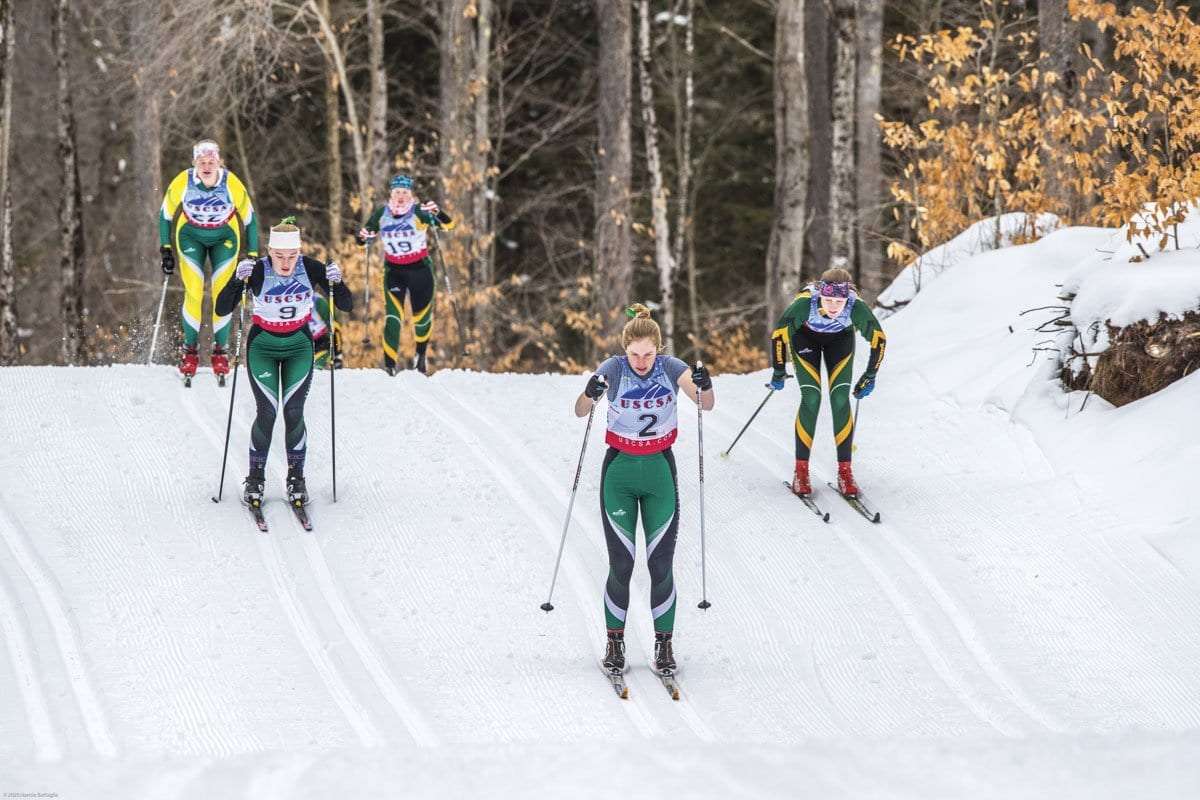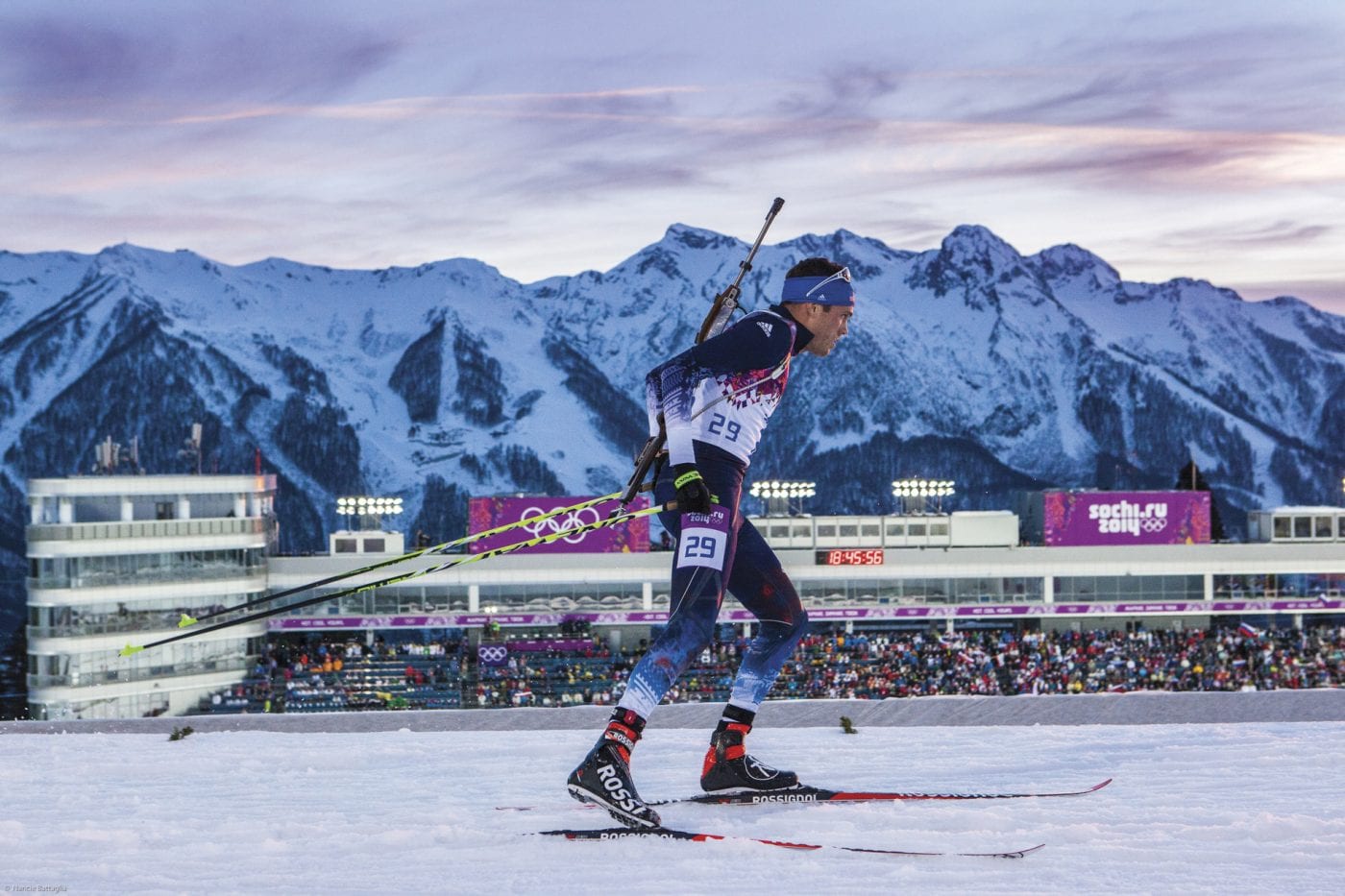
Paul Smith’s College creates trails, program to attract athletes
By Lisa Ballard
During the winter in Europe, a World Cup biathlon, an Olympic sport that combines Nordic skiing with rifle shooting, is the equivalent of Monday Night Football. Some 70,000 rowdy spectators show up and millions of television viewers tune in.
In the United States, biathlon is barely a blip on the winter sports scene, with around 1,000 total participants sprinkled around New England, Utah, Alaska, Montana, California, Minnesota, and the Adirondacks, at Mount Van Hoevenberg, on the biathlon course created for the 1980 Winter Olympics. That might change if Paul Smith’s College’s plans for its trail system at the school’s Visitor Information Center pan out.
The VIC, a nature center on the campus northwest of Saranac Lake, already maintained 40 kilometers of cross-country skiing and snowshoeing trails that looped out from the center’s main building. In just two years, Paul Smith College designed the new layout, got the permits, cleared the woods, and purchased a state-of-the-art grooming machine in its quest to create a world-class biathlon facility, which will ultimately include not only 10 kilometers of new competition-legal trails and improvements to the old ones, but also a paved roller-ski track, a second lodge, a stadium, and a shooting range with a penalty loop for when shooters miss their target.
While the upgrades have earned a designation as an official US Biathlon training site, the college also hopes to attract other Nordic skiers to the VIC. Last winter, only five months into the project, it successfully hosted a collegiate cross-country skiing competition and a ski-orienteering event during the Empire State Games. Its regular skiers returned. Curious new ones checked it out, and the VIC’s instructional and gear rental programs continued.
“It’s more than just a biathlon facility,” says John Morton, a former Olympic biathlete, team leader and chief of course who designed the new trail system. “Right away, it was clearly a major concern. Lots of people enjoyed the cross-country trails as they were, but competition trails are different. We used existing logging roads and skid trails, then tied it all to the VIC so the start area, competition loops and shooting range are part of the overall complex, and so there’s no inconvenience to recreational skiers if a competition is going on.”
Recreation news and info
Subscribe to our weekly outdoor recreation email newsletter
Morton credits Tim Burke, athletic development director at USA Biathlon, with determining the location for the new competition trails and accompanying facilities. Burke, who grew up at Paul Smith’s, where his father was an administrator, competed on the World Cup biathlon circuit for 14 seasons (2004-2018). A four-time Olympian, Burke garnered the silver medal at the 2013 world biathlon championships and was the only American to ever wear the yellow jersey, signifying his No. 1 ranking on the World Cup circuit during the 2010 season. He believes the new biathlon facility is the key to developing future stars.
“Biathlon is an endurance sport,” Burke says. “It takes a long time to develop. Most skiers are in their late 20s or early 30s before they reach their peak. It’s hard to keep athletes if they don’t have an option to continue with their education. Biathlon is not a college sport. Now, at PSC, athletes can do both.”
Why not simply drive from the college to Mount Van Hoevenberg, 45 minutes away? According to Burke, athletes wanted a closer option, plus the VIC has the ability to attract new people to biathlon. “In the U.S., you can count the number of places where you can ski and shoot on two hands,” he says. “Any time you have a new biathlon venue, we hope it attracts new athletes, but it’s not only for elite competitors. Novices and masters-level skiers are welcome, too.”
Burke emphasizes that the trail improvements will benefit a broad swath of skiers. “Growing up, skiing and running on the trails at the VIC, I was always excited to bring people there,” he says. “It’s a hidden gem.”

According to Morton, the VIC has “wonderful terrain” with adequate elevation gains to meet international competition standards, but also nice rolling hills for everyday skiers.
One obvious change is to the width of the trails. International standards require wider trails to accommodate skate-skiers.
“Trails must be 9 meters wide on climbs so that three skiers can skate side-by-side without obstructing the other,” explains Morton. “Paul Smith’s College had the added challenge that regular VIC skiers are accustomed to the narrower trails that were already there, so we created the new competition trails by Black Pond. Most of the original trails have been widened a little, to allow the new PistenBully to groom, but we still retained a couple of those old 4-foot-wide trails. We also opened up the canopy so that every inch of natural snow can reach the ground.”
Completing enough of the new trail system last winter to the point that PSC could host a college-level Nordic race seemed a miracle, considering the work began only in September 2019, but PSC had four advantages.
- It’s a forestry school that already owned and managed the timber on the acreage on which the trail system was built, so the permitting process with the Adirondack Park Agency, went smoothly.
- The permitting process for the biathlon range, due for completion this fall, also had few snafus because there had been a shooting range in that spot in the past.
- The logging contractor for harvesting the trees and the excavating contractor who popped out stumps and moved the boulders were available.
- One of the college’s trustees pledged $1 million to jump start the project financially, half the total budget.
Of that donation, $500,000 covered the cost of the trail system. Another $325,000 was earmarked for scholarships for four Nordic and four biathlon student-athletes, with most of the balance paying for the grooming machine. PSC hopes to raise an addition $1 million, including naming rights to trails and the lodge, in order to have “a Cadillac” of a biathlon and cross-country skiing facility.
“Our goal is to recruit 100 winter sports athletes in the next four years,” says John Morgan, PSC’s Director of Sports Initiatives and a former Olympic bobsledder. “Biathlon was a second target, but guys like Tim Burke were so enthusiastic, it became a priority.”
In fact, PSC initially wished for a $4.25 million turf field, paid for with seed money and grants. In February 2019, when the grant dollars didn’t happen, the college looked more seriously at developing its appeal to Nordic athletes as a way to increase enrollment. The benefit of this about-face will now extend to everyone who visits the VIC during the winter.
“The PistenBully is a game changer,” says Andy Testo, until recently the VIC’s general manager. “Now we’re able to set two tracks with a skate lane in the middle over many more kilometers. The VIC has always had quiet trails. We’ve retained those corridors, like the Heron Marsh Trail, but skiers understood that we were missing a component. After experiencing the trail network, even last winter when it was only partially completed, we have honest converts. It was revolutionary for them.”
Janet Findlay, a cross-country skier from Lake Placid, agrees. “Everyone raved about it, how beautiful it was there, and how the trails are really flowing,” she says. “We live next to Van Hoevenberg, so it wasn’t a big deal for me when I heard about it, but I figured it would be a good layout knowing who was involved.”
Findlay, who says she’s no world-class skier, ventured to the VIC last winter during the Empire State Games.
“What I like is how the trails flow,” she says. “You can keep a nice rhythm even though you’re climbing and then going downhill. Some of the downhills are substantial, but there are no sharp corners, so no need to snowplow.”
There’s generally good snow, even when other Nordic centers struggle. The VIC has the advantage of being in a location where the snow is both deeper and colder compared to many other places in the Adirondack Park. For Testo, the combination of the VIC’s snow quality and the new trail system are a dream come true, making more of the center skiable for more of the season.
“Adding the new trails and biathlon facility is a leap across the skiing spectrum!” he says.
Don’t miss a thing
This article is in the March/April 2021 issue of Adirondack Explorer.
Sign up to get it delivered 7 times a year to your mailbox!
"explorer" - Google News
March 08, 2021 at 06:33PM
https://ift.tt/3kXpUDv
Building a biathlon tradition - Adirondack Explorer
"explorer" - Google News
https://ift.tt/2zIjLrm
Bagikan Berita Ini














0 Response to "Building a biathlon tradition - Adirondack Explorer"
Post a Comment